| 1940: Polish Exiles
Scenario Preview, Part One
By Mike Bennighof, Ph.D.
January 2024
 1940: Polish Exiles is a scenario book, what we call a Campaign Study, focused on the Polish Army in France, the exiled Poles who continued to fight the Nazis after the fall of their homeland. They fielded two divisions and two brigades, and had two more divisions forming when France fell to the German onslaught. 1940: Polish Exiles is a scenario book, what we call a Campaign Study, focused on the Polish Army in France, the exiled Poles who continued to fight the Nazis after the fall of their homeland. They fielded two divisions and two brigades, and had two more divisions forming when France fell to the German onslaught.
We’ve put a lot of effort into telling the story of the 1940 campaign, with two large, complete games (1940: The Fall of France and Road to Dunkirk), an expansion book (1940: Swallows of Death) and one previous Campaign Study (1940: The Last Days of May). And we certainly plan to continue; designer Philippe Léonard has many more awaiting in store for you.
That starts with 1940: Polish Exiles. Let’s look at the first of three chapters.

A Polish armored supply column on a training exercise. Spring 1940.
Chapter One
10th Armored Cavalry Brigade
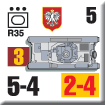 According to the agreements signed on 4 January 1940, the Polish army in exile in France would eventually include a mechanized division (DLM). Finally formed on 24 May as the embryo of the 1st Polish Armored Division, the Maczek Group was ordered to the front on 6 June. The “detached group” of the 1st Polish Armored Brigade (always called the 10th Armored Cavalry Brigade by the Poles) would include just two tank battalions mainly equipped with R40 tanks (or R35s rearmed with long-barreled guns), a squadron from the 10th Light Cavalry Regiment (PSK) and one from the 24th Uhlan Regiment, both on GMC trucks, an anti-tank company (25mm), an anti-tank battery (47 APX), an anti-aircraft battery (25mm), a company of truck-mounted sappers and a signals section. According to the agreements signed on 4 January 1940, the Polish army in exile in France would eventually include a mechanized division (DLM). Finally formed on 24 May as the embryo of the 1st Polish Armored Division, the Maczek Group was ordered to the front on 6 June. The “detached group” of the 1st Polish Armored Brigade (always called the 10th Armored Cavalry Brigade by the Poles) would include just two tank battalions mainly equipped with R40 tanks (or R35s rearmed with long-barreled guns), a squadron from the 10th Light Cavalry Regiment (PSK) and one from the 24th Uhlan Regiment, both on GMC trucks, an anti-tank company (25mm), an anti-tank battery (47 APX), an anti-aircraft battery (25mm), a company of truck-mounted sappers and a signals section.
The brigade was initially attached to the 20th Infantry Division, which asked Maczek to protect its left flank. This mission did not suit Maczek, who was eager to smash the Germans, and explains why, around 1100, the brigade carried out a reconnaissance on the Etoges-Champaubert-Montmirail axis.
Scenario One
No Man’s Land
13 June 1940
Between Fromentières and Champaubert, France
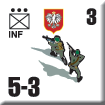 In the Champagne region, the French army faced a desperate situation: the line of the Marne abandoned and Reims occupied, while French divisions fell back in disorder towards the Seine. The first mission assigned to the 10th Armored Cavalry Brigade clearly exceeded its modest means: covering the left flank of the French 4th Army, between the 20th Infantry Division and the 59th Light Infantry Division. The Polish armored brigade first positioned itself at Montmort-Lucy on the night of 12-13 June. At dawn, the brigade moved into the Congy marshes and at around 0900, the squadron of the 24th Lancers headed towards Champaubert. In the Champagne region, the French army faced a desperate situation: the line of the Marne abandoned and Reims occupied, while French divisions fell back in disorder towards the Seine. The first mission assigned to the 10th Armored Cavalry Brigade clearly exceeded its modest means: covering the left flank of the French 4th Army, between the 20th Infantry Division and the 59th Light Infantry Division. The Polish armored brigade first positioned itself at Montmort-Lucy on the night of 12-13 June. At dawn, the brigade moved into the Congy marshes and at around 0900, the squadron of the 24th Lancers headed towards Champaubert.
Conclusion
Reinforced by added troops from the PSK plus tanks and an anti-tank platoon, the recon probe moved out from Congy, seeking to find the eastern flank of the 59th Light Infantry Division. On the road to Montmirail, the Poles quickly encountered German motorcyclists who opened fire.
The advance guard then returned towards Champaubert and, shortly after 1000, a separate motorcycle patrol set out in the same direction. Emerging from Fromentières at high speed, they were again surprised by heavy fire. The shootout cost the Poles three motorcycles along with some of the crews, but it prompted the Germans to suspend their eastwards march for almost two hours, enough time for Polish to lay a minefield.
After this setback, the Poles launched the R35 platoon in two attacks against Fromentières. Each time, they met heavy fire and eventually had to fall back. In turn, the Germans tried to outflank the Polish position but the defenders pushed them back, leaving two panzers destroyed by anti-tank fire. However, this action allowed a number of French units isolated by the German advance to withdraw in small groups.
Notes
The Poles face long odds here, forced to achieve a lot in the face of German tanks. The Germans have the edge in numbers, firepower and mobility, yet the Poles have to advance in the face of all that.
Scenario Two
Cavalry to the Rescue
13 June 1940
North of Sézanne, France
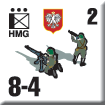 The German Group von Kleist had broken through the French front on the Marne and rushed south in pursuit of the routed French units. The 4th Panzer Division spearheaded the drive towards Sézanne, Troyes and the Seine River. At around 1000, Battle Group Boineburg seized Montmirail, pushing aside elements of the 59th Light Infantry Division. The French, aided by a company from the 4th Tank Battalion, then tried desperately to halt the advance of the panzers and allow their dislocated units to withdraw, forming small defensive hedgehogs on the roads to Sézanne. At 1230, division commander Georges-Eugène-Joseph Lascroux moved his headquarters to the eastern exit of Les Essarts, but faced with an impressive tank push on Clos-le-Roi he moved on to Lachy. The German Group von Kleist had broken through the French front on the Marne and rushed south in pursuit of the routed French units. The 4th Panzer Division spearheaded the drive towards Sézanne, Troyes and the Seine River. At around 1000, Battle Group Boineburg seized Montmirail, pushing aside elements of the 59th Light Infantry Division. The French, aided by a company from the 4th Tank Battalion, then tried desperately to halt the advance of the panzers and allow their dislocated units to withdraw, forming small defensive hedgehogs on the roads to Sézanne. At 1230, division commander Georges-Eugène-Joseph Lascroux moved his headquarters to the eastern exit of Les Essarts, but faced with an impressive tank push on Clos-le-Roi he moved on to Lachy.
Conclusion
The 59th Light Infantry Division had been formed on May 30 by renaming the 17th Infantry Division, itself formed on May 21 from the remnants of the 55th and 71st Infantry Divisions shattered in the fighting along the Meuse. It comprised two infantry regiments, the 83rd and 135th, the 47th GRDI and the 84th Artillery Regiment with two groups of 75/97 horse-drawn guns.
The 84th Artillery Regiment deployed at the edge of the forest and opened fire on the German columns, but the invaders continued to advance southwards. A combination of 150mm artillery fire and air attacks destroyed most of the French guns; French infantry, pursued by tanks, fled in panic or were surrounded. The FCM36 tanks of the 4th Tank Battalion finally intervened, but ran into the 35th Panzer Regiment. The Germans opened fire at long range, quickly destroying two French tanks, but a series of four flank attacks by the 4th Battalion’s company forced the Germans to retreat each time, enabling the French infantry and artillery to withdraw.
Around 1300, Maczek received new orders from VII Corps to act as rearguard for the 20th and 59th Infantry Divisions retreating to the southeast. Maczek chanced upon the headquarters of the 59th Light Infantry Division, on the very spot where Foch's 1914 offensive had begun. At 1600 the Polish brigade intervened to enable the French to withdraw to the southeast. But when Maczek's tanks reached their line of departure, a squadron of Hs123 biplanes appeared and the brigade lost a dozen vehicles, 12 dead and some 15 wounded.
Once the planes had left, the Polish tanks deployed and went on the attack. Two companies made rapid progress and surprised a reconnaissance detachment supported by anti-tank guns. In the ensuing exchange of fire, the Poles put two armored cars out of action, but suffered damage to two R35s. In the end, the Polish brigade had no choice but to withdraw at around 1800. By evening, the 59th Light Infantry Division had all but ceased to exist.
Notes
The French are on their own when the scenario opens, under pressure from a strong German armored force before the Poles arrive to hopefully save the day. The goal is to get the French safely off the map, while the Germans are trying to stop that and rampage off the map their ownselves.
Scenario Three
Overwhelmed
16 June 1940
Near Chaource, France.
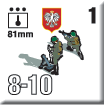 Masses of refugees fled along the roads while French soldiers wandered beside them, unarmed, leaderless and aimless. The Poles watched in despair as they themselves joined the sad retreat. The French 4th Army’s withdrawal towards the Loire River opened up a huge gap between the two wings of the army, into which the German units rushed southwards. After crossing the Seine River at Bar-sur-Seine on the evening of 15 June, Maczek's brigade regrouped in the forest of Chaource. In the early hours of the 16th, the Polish brigade received the order to move out as an advance guard to occupy Montbard and open the road to allow the 42nd Infantry Division and 240th Light Infantry Division (DLI) to pass southwards. Masses of refugees fled along the roads while French soldiers wandered beside them, unarmed, leaderless and aimless. The Poles watched in despair as they themselves joined the sad retreat. The French 4th Army’s withdrawal towards the Loire River opened up a huge gap between the two wings of the army, into which the German units rushed southwards. After crossing the Seine River at Bar-sur-Seine on the evening of 15 June, Maczek's brigade regrouped in the forest of Chaource. In the early hours of the 16th, the Polish brigade received the order to move out as an advance guard to occupy Montbard and open the road to allow the 42nd Infantry Division and 240th Light Infantry Division (DLI) to pass southwards.
The 10th Brigade established itself in this new position at dawn, after exchanging fire with patrols of the German 13th Motorized Infantry Division approaching from Tonnerre. Later that morning, behind the Maczek brigade, German armored cars harassed the remnants of the 240th DLI. The whole French maneuver had been aimed at getting the encircled units out of the trap and preventing the Germans from advancing towards Dijon.
The Poles now had to rush to block the Germans. The Maczek group would take Montbard and pave the way for the 240th DLI’s escape. However, fuel shortages forced the Poles to abandon some of their tanks, and they only retained 17 R35s when column started marching southward around 1500.
Conclusion
From the outset, accurate German machine-gun fire targeted the Polish rearguard. As the convoys formed up, the R35s covering the Chaource road came under fire. One damaged tank had to be abandoned, while the others opened fire and protected the advancing troops. The anti-tank platoon that should have filled this role failed to carry out the order and had to be brought into position by Major Wladyslaw Zgorzelski himself.
Once on the road, two motorized platoons missed a fork in the road and rushed straight at the Germans but managed to get away. Meanwhile, other retreating French units tried their luck pushing southwards, crossing paths with the Poles. Some of these units made heroic sacrifices to stem the German onslaught: one French company held the village of Balnot-la-Grange until the evening, against repeated attacks. Once they had reached the main road, the Poles faced traffic jams and a panic triggered by an explosion.
Late in the afternoon, the rear-guard was surprised by panzer-reinforced enemy infantry. An immediate counter-attack put the attackers to flight, leaving 30 prisoners behind. Despite the victory, the Poles had been cut off.
Notes
This is an odd scenario, played out on a long, narrow board with the Poles trying to break out to the east, the French trying to break out to the south, and the Germans coming from the west and the south, trying to get into their paths. This one is going to call for swift maneuver, and while the Poles and the Germans are pretty swift, the French are not.
Scenario Four
Roadblock
16 June 1940
Molesme, France
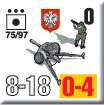 The Polish brigade’s anti-tank company had fallen in with the remnants of the French 53rd DLI, but a random encounter at a bridge over the Seine brought them back into the fold. Their new friends joined Maczek as well, a mixed collection of French, African and Arab infantrymen still ready to fight the Nazi invaders. In the late afternoon they ran into tank-supported Germans, as the vanguard of the 13th Motorized Infantry Division blocked the road ahead and tried to envelop the motley collection of anti-fascists. French-speaking Polish officers quickly organized a counter-attack. The Polish brigade’s anti-tank company had fallen in with the remnants of the French 53rd DLI, but a random encounter at a bridge over the Seine brought them back into the fold. Their new friends joined Maczek as well, a mixed collection of French, African and Arab infantrymen still ready to fight the Nazi invaders. In the late afternoon they ran into tank-supported Germans, as the vanguard of the 13th Motorized Infantry Division blocked the road ahead and tried to envelop the motley collection of anti-fascists. French-speaking Polish officers quickly organized a counter-attack.
Conclusion
Supported by the Polish anti-tank guns, the French infantry opened a two-pronged attack that levered the Germans out of Molesme and into a nearby wood, where an unrecorded number of Germans were surrounded and massacred. The attack had opened the road south, but the remaining Polish tanks ran out of fuel and had to be abandoned, with their crews joining the march on foot. Soon afterwards, a German patrol ambushed one of the Polish anti-tank guns. The small multi-national column had been cut off from the rest of Maczek’s brigade.
Notes
This is a small scenario, with a mixed group of Poles, French and North Africans on the attack to open the road south. The Germans are badly out-numbered, but the Poles and their friends have to come at them if they want to meet their objectives.
Scenario Five
Polish Revenge
16 June 1940
Montbard, France
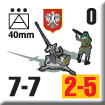 Maczek's Polish brigade reached the heights overlooking Montbard at sunset, only to find that the Germans had already occupied the town during the afternoon. Maczek called his men together and delivered a blistering speech, reminding them of their opportunity to fight again and take revenge on the Nazi regime that had laid Poland to waste. Maczek planned a surprise attack, spearheaded by his tanks and Polish infantry with his engineers in reserve. These elements would capture a bridge over the Burgundy Canal to allow his group to continue their retreat. Maczek's Polish brigade reached the heights overlooking Montbard at sunset, only to find that the Germans had already occupied the town during the afternoon. Maczek called his men together and delivered a blistering speech, reminding them of their opportunity to fight again and take revenge on the Nazi regime that had laid Poland to waste. Maczek planned a surprise attack, spearheaded by his tanks and Polish infantry with his engineers in reserve. These elements would capture a bridge over the Burgundy Canal to allow his group to continue their retreat.
Conclusion
The Polish R35 light tanks came up against the first barricade at around 2200. They accelerated and, firing all of their weapons, forced their way through. Behind them, the Polish riflemen advanced, flanked by a detachment of Senegalese riflemen from a disbanded colonial division who had joined the Maczek group the day before. The enemy - a reinforced battalion of the 13th Motorized Infantry Division’s 66th Regiment - initially put up little resistance. The Polish attack then slowed as the leading squadron, lacking a map, lost its direction and veered south. The young soldiers’ lack of training also favored the defenders: some combat groups advanced by walking in the middle of the streets, without seeking protection along the walls.
After half an hour, the 10th PSK squadron reinforced the attackers. A grenade soon wounded its commander, Captain Otton Eysymont, but the attack continued, correcting towards the west. The tanks, hampered by the narrow alleyways and the darkness, struggled to maneuver. This forced their commanders to get out and guide them from the outside. On reaching the banks of the Brenne River, one of the tanks missed the bridge, tumbled off the bank and fell into the river. Despite these difficulties and mounting losses, support from the R35s enabled the mounted rifle platoons to cross the bridge over the Brenne and enter the town center. On the opposite bank, the German battalion's resistance weakened, and the exchange of fire died down. A reconnaissance at around 0300 found the town center silent and abandoned. Just 500 meters away, the bridges over the Burgundy canal lay within reach.
Just as victory seemed assured, a dispatch rider informed Maczek that neither French division had followed the Poles, and instead headed for Dijon. At the same time, a false rumor led Maczek to believe that the bridge over the Burgundy canal had just been destroyed, when in fact it had not. Without add French infantry and artillery reinforcements, and without the bridge over the canal, it would be unthinkable to open a passage. Maczek reluctantly decided to abandon Montbard.
The fighting was brief, but the toll was ferocious: the Germans lost around forty killed or seriously wounded plus a whole list of weapons and vehicles; the Poles lost 12 killed, 45 wounded and three tanks. The German division staff considered the situation dire enough to ask a nearby Armed SS militia formation for assistance, which never arrived before the Poles broke off their attack.
Notes
This is a knife-fight in a phonebooth, with the Poles on the attack trying to seize control of a single mapboard. The Poles (and their Senegalese friends) have morale and armor on their side; the Germans hold the key positions but not nearly enough anti-tank protection for what the Poles can unleash on them.
And that is all for Chapter One!
You can order 1940: Polish Exiles right here.
Polish-Lithuanian Commonwealth
The Deluge
Lithuania's Iron Wolves
Legend of the Iron Wolf
1940: Polish Exiles
Retail Price: $90.96
Package Price: $70
Gold Club Price: $56
You can join the Commonwealth right here.
Sign up for our newsletter right here. Your info will never be sold or transferred; we'll just use it to update you on new games and new offers.
Mike Bennighof is president of Avalanche Press and holds a doctorate in history from Emory University. A Fulbright Scholar and NASA Journalist in Space finalist, he has published a great many books, games and articles on historical subjects; people are saying that some of them are actually good.
He lives in Birmingham, Alabama with his wife, three children, and new puppy. He misses his lizard-hunting Iron Dog, Leopold.
Want to keep Daily Content free of third-party ads? You can send us some love (and cash) through this link right here.
|
